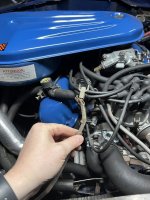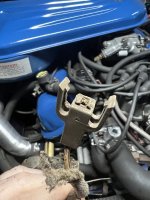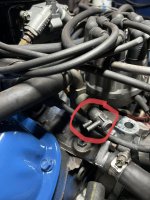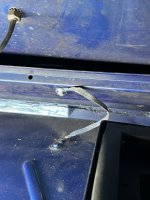Bronco_007
Jr. Member
Good evening, my people. I got under the hood today and one thing led to another. You know the drill.
1974 stock 302, 3 on the tree.
Mystery #1:
I went to start the engine and nothing happened. Lights wouldn’t work either. Time for a new battery.
So I got one, and installed it. Tried to start it; an attempt was made without success. I hear a loud click from the area of the starter, and nothing else. The lights work, so the battery is good.
I checked under the hood again and found this just hanging out:

The connector looks pretty gnarly. Might need to be replaced; certainly cleaned.

I have no idea where it is supposed to go. It originates at the bottom of the alternator:

Could it have anything to do with why she won’t turn over?
Mystery #2:
While looking around under there I notice this (also have no idea what it is), that looks like it might oughtta have a hose or two attached to it, maybe?

Passenger side, top of engine, above the valve cover, at the front corner. School me, please.
Mystery #3:
Awhile ago I noticed what looks to be some type of ground connection in the engine bay, one the drivers’ side, just medial to the fresh air vent box. It appears to be made of fiber, not wire. It wasn’t attached to anything at first, just laying there. But I found a hole just above it in the hood, so I used a small bolt and washer to attached it. Figured if it was some type of ground, it should probably be grounded…

What is this? Is it just a connector to ensure any aberrant static in the hood grounds out in the body?
Appreciate all the schooling I can get, as always. Happy New Year!
1974 stock 302, 3 on the tree.
Mystery #1:
I went to start the engine and nothing happened. Lights wouldn’t work either. Time for a new battery.
So I got one, and installed it. Tried to start it; an attempt was made without success. I hear a loud click from the area of the starter, and nothing else. The lights work, so the battery is good.
I checked under the hood again and found this just hanging out:

The connector looks pretty gnarly. Might need to be replaced; certainly cleaned.

I have no idea where it is supposed to go. It originates at the bottom of the alternator:

Could it have anything to do with why she won’t turn over?
Mystery #2:
While looking around under there I notice this (also have no idea what it is), that looks like it might oughtta have a hose or two attached to it, maybe?

Passenger side, top of engine, above the valve cover, at the front corner. School me, please.
Mystery #3:
Awhile ago I noticed what looks to be some type of ground connection in the engine bay, one the drivers’ side, just medial to the fresh air vent box. It appears to be made of fiber, not wire. It wasn’t attached to anything at first, just laying there. But I found a hole just above it in the hood, so I used a small bolt and washer to attached it. Figured if it was some type of ground, it should probably be grounded…

What is this? Is it just a connector to ensure any aberrant static in the hood grounds out in the body?
Appreciate all the schooling I can get, as always. Happy New Year!
















